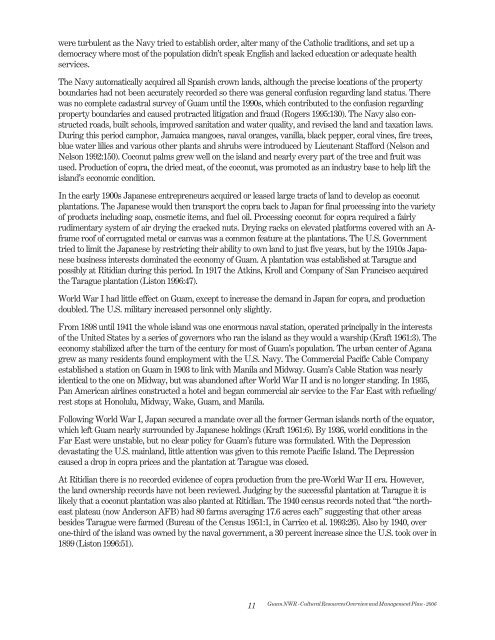Guam National Wildlife Refuge Comprehensive Conservation Plan
Guam National Wildlife Refuge Comprehensive Conservation Plan
Guam National Wildlife Refuge Comprehensive Conservation Plan
You also want an ePaper? Increase the reach of your titles
YUMPU automatically turns print PDFs into web optimized ePapers that Google loves.
were turbulent as the Navy tried to establish order, alter many of the Catholic traditions, and set up a<br />
democracy where most of the population didn’t speak English and lacked education or adequate health<br />
services.<br />
The Navy automatically acquired all Spanish crown lands, although the precise locations of the property<br />
boundaries had not been accurately recorded so there was general confusion regarding land status. There<br />
was no complete cadastral survey of <strong>Guam</strong> until the 1990s, which contributed to the confusion regarding<br />
property boundaries and caused protracted litigation and fraud (Rogers 1995:130). The Navy also constructed<br />
roads, built schools, improved sanitation and water quality, and revised the land and taxation laws.<br />
During this period camphor, Jamaica mangoes, naval oranges, vanilla, black pepper, coral vines, fire trees,<br />
blue water lilies and various other plants and shrubs were introduced by Lieutenant Stafford (Nelson and<br />
Nelson 1992:150). Coconut palms grew well on the island and nearly every part of the tree and fruit was<br />
used. Production of copra, the dried meat, of the coconut, was promoted as an industry base to help lift the<br />
island’s economic condition.<br />
In the early 1900s Japanese entrepreneurs acquired or leased large tracts of land to develop as coconut<br />
plantations. The Japanese would then transport the copra back to Japan for final processing into the variety<br />
of products including soap, cosmetic items, and fuel oil. Processing coconut for copra required a fairly<br />
rudimentary system of air drying the cracked nuts. Drying racks on elevated platforms covered with an Aframe<br />
roof of corrugated metal or canvas was a common feature at the plantations. The U.S. Government<br />
tried to limit the Japanese by restricting their ability to own land to just five years, but by the 1910s Japanese<br />
business interests dominated the economy of <strong>Guam</strong>. A plantation was established at Tarague and<br />
possibly at Ritidian during this period. In 1917 the Atkins, Kroll and Company of San Francisco acquired<br />
the Tarague plantation (Liston 1996:47).<br />
World War I had little effect on <strong>Guam</strong>, except to increase the demand in Japan for copra, and production<br />
doubled. The U.S. military increased personnel only slightly.<br />
From 1898 until 1941 the whole island was one enormous naval station, operated principally in the interests<br />
of the United States by a series of governors who ran the island as they would a warship (Kraft 1961:3). The<br />
economy stabilized after the turn of the century for most of <strong>Guam</strong>’s population. The urban center of Agana<br />
grew as many residents found employment with the U.S. Navy. The Commercial Pacific Cable Company<br />
established a station on <strong>Guam</strong> in 1903 to link with Manila and Midway. <strong>Guam</strong>’s Cable Station was nearly<br />
identical to the one on Midway, but was abandoned after World War II and is no longer standing. In 1935,<br />
Pan American airlines constructed a hotel and began commercial air service to the Far East with refueling/<br />
rest stops at Honolulu, Midway, Wake, <strong>Guam</strong>, and Manila.<br />
Following World War I, Japan secured a mandate over all the former German islands north of the equator,<br />
which left <strong>Guam</strong> nearly surrounded by Japanese holdings (Kraft 1961:6). By 1936, world conditions in the<br />
Far East were unstable, but no clear policy for <strong>Guam</strong>’s future was formulated. With the Depression<br />
devastating the U.S. mainland, little attention was given to this remote Pacific Island. The Depression<br />
caused a drop in copra prices and the plantation at Tarague was closed.<br />
At Ritidian there is no recorded evidence of copra production from the pre-World War II era. However,<br />
the land ownership records have not been reviewed. Judging by the successful plantation at Tarague it is<br />
likely that a coconut plantation was also planted at Ritidian. The 1940 census records noted that “the northeast<br />
plateau (now Anderson AFB) had 80 farms averaging 17.6 acres each” suggesting that other areas<br />
besides Tarague were farmed (Bureau of the Census 1951:1, in Carrico et al. 1993:26). Also by 1940, over<br />
one-third of the island was owned by the naval government, a 30 percent increase since the U.S. took over in<br />
1899 (Liston 1996:51).<br />
11 <strong>Guam</strong> NWR - Cultural Resources Overview and Management <strong>Plan</strong> - 2006

















